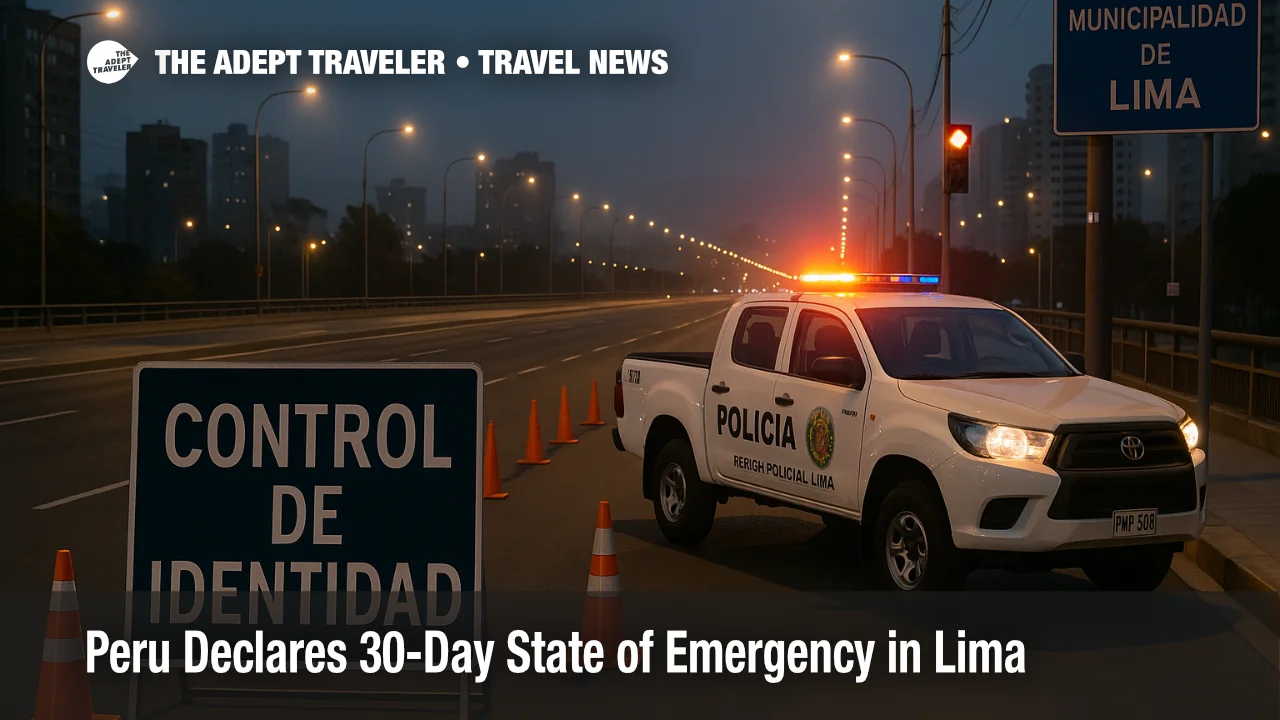Peru Declares 30-Day State of Emergency in Lima

Key points
- Peru enacted a 30-day state of emergency in Lima and Callao starting October 22, 2025
- Armed forces will support the National Police and authorities may restrict movement and assembly
- Travelers should carry passports, avoid crowds, and keep a low profile per the U.S. Embassy
- Expect increased checkpoints, ID inspections, and potential roadblocks or localized curfews
- Monitor the U.S. Embassy Lima website for security updates and instructions
Impact
- Who Is Affected
- Travelers and residents in Lima and the Constitutional Province of Callao
- What Changed
- A 30-day state of emergency authorizing armed forces to support police and allowing restrictions on movement and assembly
- When It Applies
- Effective October 22, 2025, for 30 days
- Where It Applies
- Lima and Callao, including transit corridors to Jorge Chávez International Airport
- Why It Was Declared
- Implemented in response to rising security concerns, including violent crime and extortion
- Official Guidance
- Carry your passport, comply with ID checks, avoid crowds, keep a low profile, do not resist robbery attempts, and monitor U.S. Embassy Lima updates
Peru declared a 30-day state of emergency for Lima and the adjacent province of Callao beginning October 22, 2025, citing a surge in violent crime and extortion. The decree enables the armed forces to support the National Police and grants authorities power to restrict movement and assembly. For travelers, this means visible military patrols, more frequent identity checks, and the possibility of rapid, localized curfews or cordons that can disrupt transport plans. The U.S. Embassy in Lima issued a security alert with practical guidance for visitors and residents.
Lima and Callao, what changed and why it matters
Under the emergency decree, security forces can expand operations to maintain public order in Peru's capital and its main port district. While tourism infrastructure remains open, the operational environment is tighter. Officers may request identification at any time, and patrols are likely to concentrate near transport hubs, business districts, nightlife corridors, and shopping areas where opportunistic crime has increased. The combination of police and military presence aims to deter violent incidents, but it also introduces the likelihood of temporary roadblocks, redirected traffic, and crowd-control actions that can affect day-to-day movement.
Latest developments
Peruvian authorities announced the emergency on October 22, following cabinet approval and a televised address outlining the security focus. International outlets report the measure is part of a broader push to combat homicides, armed robberies, and extortion in the capital region, with the government signaling a more aggressive posture against organized criminal groups. The U.S. Embassy published an English and Spanish security alert the same day, emphasizing heightened caution and readiness to show identification when requested.
Analysis
For most itineraries, the biggest practical change is friction in mobility rather than outright closures. Expect spot checks on major arterials between Lima's hotel zones, Miraflores and San Isidro, and Jorge Chávez International Airport in Callao. Ride-hail services and taxis may be rerouted or delayed when operations surge, particularly during evening and late-night hours. Travelers should keep their passport on them at all times, consistent with Peruvian law, and store a digital copy in an encrypted cloud folder as backup. A minimalist carry approach helps: leave high-value jewelry and watches at the hotel safe, spread cards between a wallet and a concealed pouch, and use tap-to-pay where possible to avoid handling cash in public.
Crowd dynamics will also matter more than usual. Demonstrations can form quickly around government buildings and landmark plazas, then be dispersed with little warning. If you encounter a gathering, change course early to avoid getting boxed in by a line of officers or vehicle barricades. In nightlife areas, stay on well-lit streets, move in small groups, and pre-select routes back to your hotel that minimize isolated blocks. If confronted in a robbery attempt, the Embassy's guidance is unequivocal: do not resist, prioritize your safety, and report the incident to local police once you are secure.
Background
A state of emergency in Peru is a time-limited measure that permits the government to deploy the armed forces for internal security, alongside the National Police, and to restrict certain constitutional rights, including freedom of movement and assembly. Decrees are issued by the executive branch and published in the official gazette; they are commonly set for 30 days and may be renewed. For travelers, this typically translates to increased checkpoints, faster dispersal of gatherings, and targeted operations in areas with elevated crime.
Final thoughts
The 30-day state of emergency in Lima and Callao, in effect since October 22, 2025, is designed to curb violent crime, and it brings a more assertive security posture that visitors will notice on the street. Keep your passport on you, avoid crowds, plan extra time for airport and city transfers, and follow instructions from officials. Continue to monitor the U.S. Embassy's alerts for any adjustments while the state of emergency remains active.
